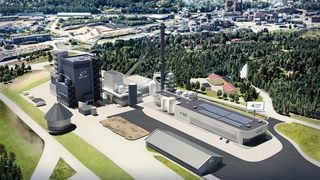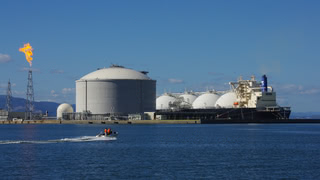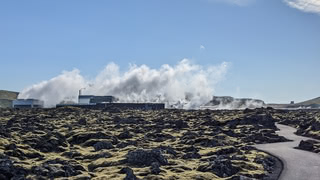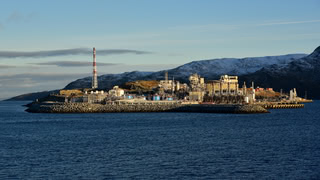Why no one wanted to buy the Green Shipping Fuel
Many shipping companies see e-methanol - made from hydrogen and carbon dioxide - as the most promising future clean fuel. But it appears they do not want to buy it: energy company Ørsted canceled plans for an e-methanol production facility due to a lack of offtake agreements. A weakened EU regulation has likely contributed to the difficulty of selling green shipping fuels.
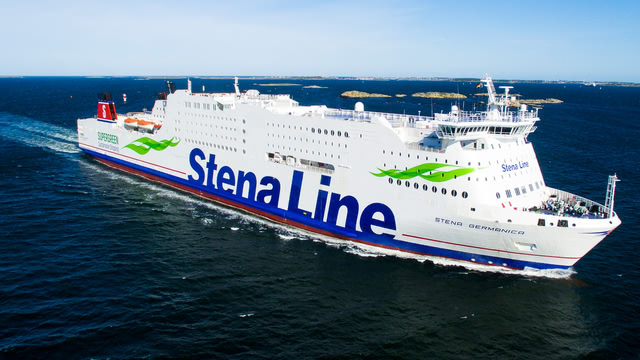
In an unexpected move, the Danish renewable energy company Ørsted has announced that it will not further pursue plans to build the e-methanol plant FlagshipONE in Sweden. In a press release, Ørsted writes: "The liquid e-fuel market in Europe is developing slower than expected, and we have taken the strategic decision to de-prioritise our efforts within the market and cease the development of FlagshipONE."
FlagshipONE looked like a promising project. E-methanol, made from carbon dioxide and green hydrogen, is seen by many as a crucial tool for a decarbonized future. Swedish startup LiquidWind originally started the project, Ørsted joined in January 2022 as a partner and later acquired the whole project.
In recent years, many green methanol projects have been announced, but often, they remained mere announcements or feasibility studies. But Ørsted had already announced a "final" investment decision for FlagshipONE in 2022. In May 2023, Ørsted broke ground for the construction of the project.
Everything looked promising. The renewable energy giant Ørsted appeared like the kind of company that could pull off such a major clean energy project. According to Ørsted, it was "the largest e-methanol project under construction in Europe". Unlike some other Carbon Capture and Utilization projects, it had an existing bioenergy plant as its carbon source - a less controversial source compared to other CCU and e-fuels projects that plan to use fossil CO₂ sources.
The project received around 15 million Euros in investment from Klimatklivet, a Swedish government-run fund to support promising climate mitigation technologies.
Furthermore, the EU-Catalyst Partnership, a collaboration between the European Commission, the European Investment Bank, and Breakthrough Energy Catalyst - an investment platform supported by Bill Gates - would have provided additional funding. But all that was not enough to actually build and operate the project.
While Ørsted had political support, subsidies, and funding, apparently, what it lacked were customers. The energy company was unable to secure long-term offtake agreements. Nobody wanted to buy Ørsted's green methanol.
From Fossil to Renewable Methanol
Methanol is the simplest carbon-containing liquid. It is already widely used in the chemical industry and as a fuel additive. Today's production is almost entirely based on either fossil gas or coal. Methanol production already causes considerable carbon emissions, but even larger are the emissions from carbon embodied in the product. When burned as a fuel or turned into products that eventually end up in waste incinerators, that carbon gets released as carbon dioxide.
Methanol can alternatively be made from biomass through various production paths and potentially also from waste. However, those options are either limited or come with considerable risks and indirect emissions. E-methanol can potentially be a scalable option with a very low climate impact, although questions like the additionality of the energy supply or the source of carbon dioxide should always be carefully considered.
E-methanol could potentially be used as a chemical feedstock for products like plastics or as an energy storage solution. However, the main reason why e-methanol gained traction is the shipping industry.
Stena Line, Maersk, and Methanol as a future Shipping Fuel
In 2015, Swedish ferry operator Stena Line ordered ship-engine maker Wärtsilä to overhaul the engine of the Stena Germanica, a passenger ferry connecting Kiel in Germany with Gothenburg in Sweden. Stena Line's at the time unusual choice was to order dual-fuel engines that could operate either with conventional oil-based shipping fuel or with methanol.
At the time, the shipping industry was primarily concerned with air pollution and focused on liquefied fossil gas (LNG) as its primary "alternative" fuel. However, LNG does little, if anything, to reduce greenhouse gasses. (Hypothetically, LNG could be replaced by e-methane, similarly made from CO2 and hydrogen, or biomethane. But that comes with additional challenges - like methane emissions due to incomplete combustion.)
Stena Line initially used fossil-based methanol, and even that only for a fraction of its fuel consumption. But the ferry company already had a later switch to green methanol sources in mind.
On information posters it showed to its passengers, Stena Line wrote: "The best thing about methanol is that it actually can be made out of garbage or biomass or even produced from water and carbon dioxide, creating a totally climate neutral cycle."
Stena Line later purchased small amounts of green methanol from a pilot facility built by Carbon Recycling International and operated at a steel plant in Sweden. Carbon Recycling International is the oldest e-methanol company and has been operating a small e-methanol plant in Iceland since 2012.
While Stena Line was the pioneer in using methanol as a shipping fuel, the idea gained major traction when a much larger player entered the game. In 2021, the danish container shipping giant Maersk started ordering ships with dual-fuel engines capable of using methanol. More orders followed in the following years. Overall, Maersk has ordered 25 ships with methanol-ready engines.
Maersk's move was widely seen as a sign that green methanol had the best chance of becoming the shipping fuel of the future. The other widely discussed alternative is green ammonia, which has the advantage that it does not need a carbon source, but the big disadvantage is that it is a major safety risk. Ammonia is extremely toxic.
Maersk did not just order ships with methanol-capable engines. It also made investments in technology development for e-methanol production. Those include investments into the startup C1 Green Chemicals from Berlin, Germany, a company developing more efficient methanol synthesis technology based on quantum simulation.
Methanol's future as a clean shipping fuel looked promising. Other shipping companies also ordered methanol-ready engines. The Port of Gothenburg in Sweden announced that it wants to become an electromethanol-hub, a partnership with Stena Line, Ørsted, Liquidwind, and DFDS, a ferry and cargo ship operator from Denmark.
But it is one thing to announce projects, make plans, and signal intent to run ships on e-methanol - and quite another whether these plans actually materialize. Many of the proposed methanol production plants are still in the planning stages, and shipping companies ordering dual-fuel engines can run them on conventional, oil-based shipping fuels.
Lately, bad news for methanol's future as a clean shipping fuel started piling up. In August 2024, Maersk announced it would order 50 to 60 new LNG ships.
"While green methanol is likely to become the most competitive and scalable pathway to decarbonisation in the short term, Maersk also foresees a multifuel future for the industry which includes liquified bio-methane", Maersk wrote in its press release. One may question whether the claim that methanol is "likely to become the most competetive and scalable pathway to decarbonization in the short term" is consistent with ordering twice as many LNG ships, with a vague reference to bio-methane that comes with the risk of unaccounted landuse and methane slip emissions.
Maersk's announcement, which many saw as a U-turn on methanol, came only weeks before Ørsted's decision to scrap FlagshipONE. While it is unclear whether there is any connection between the two events, Maersk would have been a very plausible customer for Ørsted's e-methanol factory. Other likely candidates would have been methanol pioneer Stena Line or DFDS, the two companies that two years earlier had announced a partnership with Ørsted for an e-methanol hub in Gothenburg.
When asked for a comment, DFDS wrote: "It has been more than a year since we have been in concrete dialogue with Ørsted about FlagshipONE, so we cannot comment on the basis of the decision to close the project." That seems quite remarkable, particularly given that in an interview with S&P Global in October 2024, DFDS CEO Torben Carlsen indicated that the company would like to operate ships on carbon-neutral e-methanol as soon as 2025, but he was not optimistic about availability of e-methanol by then.
I also asked Stena Line for a comment. In their answer, they did not directly reference the FlagshipONE project: "When it comes to methanol, we are actively exploring different options to secure a reliable supply of renewable methanol, as we already have the capacity to utilise it in our fleet. However, transitioning to renewable methanol requires advancements in the logistical infrastructure needed to handle alternative fuels, making it difficult to provide a clear timeline at this moment."
EU Regulation allows not using any Renewable Fuels for another Decade
While shipping companies making grand announcements about their intention to purchase green fuels but not signing offtake agreements when it matters is certainly noteworthy, the explanation likely comes down to economics. While renewable e-methanol is a promising decarbonization technology, it requires very substantial amounts of energy to produce it. This is unavoidable for any technology trying to convert low-energy CO2 molecules into something with a high energy content.
In the forseeable future, renewable e-methanol will be substantially more expensive than conventional oil-based shipping fuels like marine diesel or LSFO.
Some policies have been enacted to incentivize the shipping industry to reduce their carbon footprint. The International Maritime Organization (IMO) has set emission reduction targets, and shipping emissions have been included in the European Emission Trading System. However, while renewable fuels like e-methanol or e-ammonia will likely be needed to bring down shipping emissions significantly, they are relatively expensive technologies. Neither the near-term IMO requirements nor the ETS are incentive enough to kickstart a market for those clean fuels.
During negotiations for the FuelEU Maritime regulation, it was therefore proposed to incentivize the uptake of such fuels by introducing a quota. In EU policy, fuels like hydrogen and other chemicals made from renewable energy are called Renewable Fuels of Non-Biological Origin or RFNBOs. (Confusingly, that does not mean that the carbon in those fuels is of non-biological origin. It only refers to the energy content and separates RFNBOs from biofuels that come with considerable controversies and risks.)
Given that such e-fuels, or RFNBOs, are currently not produced in any meaningful quantities, even an initially small quota that would incur modest costs for shipping companies would likely be a major push for their production.
Seven EU member states - Belgium, Denmark, Germany, Ireland, Luxemburg, the Netherlands, and Sweden - proposed a target of 2.8 percent RFNBOs for shipping fuels by 2030. The European Parliament suggested a quota of 2 percent by 2030. The CCU industry association CO2 Value Europe proposed even earlier quotas.
Even lobbying organizations from the shipping industry appeared positive towards such a quota. In a statement by the European Community Shipowners' Associations, they write that they support the EU Parliament's proposal for a 2030 quota in principle but want similar requirements for fuel suppliers. (Update/2024-10-03: ECSA has removed that statement from their web page, link goes to the Internet Archive / Wayback Machine.)
If any of these proposals had been passed, the fate of FlagshipONE might have been different. However, the EU eventually agreed to much weaker requirements. A quota of 2 percent RFNBOs would only start in 2034, and even that comes with some caveats. Under the final FuelEU Maritime regulation, shipping companies would not have any requirement to purchase relatively expensive e-fuels for another decade and can likely fulfill the modest emission reduction requirements while still primarily relying on fossil fuels.
Jacob Armstrong, who works for the NGO Transport & Environment, wrote me that he sees the FuelEU Maritime RFNBO quota as "too little too late". Furthermore, Armstrong writes: "We had been warning for a while that we need a stronger, more ambitious policy framework. This announcement from Ørsted is an unfortunate but clear vindication of what we've been saying. So we're calling for the new European Commission, which will come into power this year, to rectify this: higher RFNBO specific targets, sooner."
The FuelEU Maritime regulation still requires shipping companies to achieve modest emission reductions earlier. However, the most likely paths include LNG or biofuels. Both paths come with a considerable risk of undercounting emissions. Biofuels have difficult to quantify, but often underestimated landuse-related emissions, and LNG has additional emissions due to methane leakage. Methane slip in ship engines has only been measured in a small number of studies, and they tend to see much higher methane slip than expected.
During the EU negotiations for the FuelEU Maritime regulation, concerns were raised that more ambitious RFNBO goals would be impractical due to a lack of availability. Also, shipping companies regularly named a lack of availability as a problem with e-methanol.
The cancelation of FlagshipONE indicates an entirely different problem: rather than a lack of supply and availability, it is more likely a lack of reliable demand that is hindering progress on the development of those fuels. While the EU is willing to provide investment support and subsidies (the EU also supports multiple other e-methanol projects through its Innovation Fund), none of that matters when there is no market for those fuels.
When the regulation was finalized, EU parliament rapporteur Jörgen Warborn (Swedish Moderate Party, EPP group) called it "truly ground-breaking" and said: "We guarantee the sector long-term rules and predictability, so that they dare to invest." It appears Ørsted did not dare to invest into a fuel that it might not sell in meaningful quantities for another decade.
Update: In February 2025, Liquid Wind, the company that initially started FlagshipONE, announced plans for an even larger E-Methanol facility at the same location.
Author: Hanno Böck
Brief
-
Texas is often mentioned as a place were renewables have lately been built in large quantities. Ketan Joshi looks at the numbers, and while it is true in absolute numbers, it is not necessarily good news for the climate.
-
A biochemical refinery is starting production at the chemical park Leuna in Germany.
-
Like shipping, aviation is a sector where e-fuels may be the only scalable decarbonization option. While often discussed, such e-saf or e-kerosene is currently not produced in meaningful quantities. The only company that actually produces e-kerosene is atmosfair. In a press release announcing its first e-kerosene production, atmosfair wrote these remarkable sentences: "At the same time, according to atmosfair, the aviation industry should stop suggesting that climate-friendly flying is feasible at today's levels, as green electricity-based kerosene is very energy-intensive. In Werlte, atmosfair must use more than five times the amount of energy from wind and solar power to produce the kerosene compared to the energy content of the kerosene itself. Even with future optimisation, the current global capacity of renewable energies would need to be doubled just to supply today's global air traffic with electricity-based kerosene. Therefore, only a fraction of today's air traffic can be covered in the next few decades. That is why flying less remains the most important way to preserve the climate."
-
Some of my readers will known that apart from writing about cleantech and decarbonization, I have a background in IT security. Decentralized energy production and storage is an important tool for the energy transition, but it comes with new IT security risks (I have reported about an example here before). Recently, IT security researcher Ryan Castellucci found out that tens of thousands of grid-connected batteries could be controlled with an easily breakable cryptographic key.Bert Hubert wrote a lengthy blog post about the security risk of decentralized, Internet-connected energy production.
